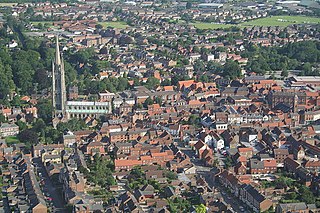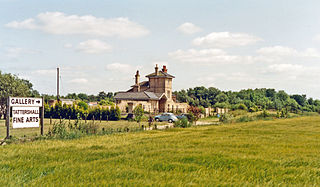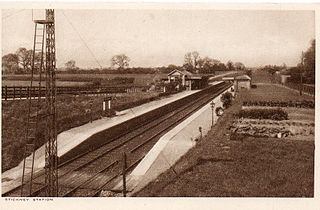
East Lindsey is a local government district in Lincolnshire, England. Its council is based in Horncastle and the largest town is Skegness. Other towns include Alford, Burgh le Marsh, Coningsby, Louth, Mablethorpe, Spilsby, Sutton on Sea, Wainfleet All Saints, Wragby and Woodhall Spa. The district also covers a large rural area, including many smaller settlements.

Coningsby is a town and civil parish in the East Lindsey district in Lincolnshire, England, it is situated on the A153 road, adjoining Tattershall on its western side, 13 miles (21 km) north west of Boston and 8 miles (13 km) south west from Horncastle.

Ingrow is a suburb of Keighley, West Yorkshire, England that lies on the River Worth. The name Ingrow comes from Old Scandinavian which means 'corner of land in the meadow.' The suburb is located on the A629 road and is 0.93 miles (1.5 km) south west of Keighley town centre.

Dogdyke railway station was a station on the former Great Northern Railway between Boston and Lincoln.

Tumby Woodside railway station was a station in Tumby Woodside, Lincolnshire, England on the Kirkstead and Little Steeping Railway which ran between Lincoln and Firsby. The site is now left in an overgrown and unkempt state. The station masters house survives as a private residence. It served the village until closure in 1970 and was immortalised in 1964 in the song "Slow Train" by Flanders and Swann.
Hesketh Bank railway station was a railway station on the West Lancashire Railway (WLR) in North West England, which served the village of Hesketh Bank. The station, originally known as 'Hesketh Bank and Tarleton', opened on 20 February 1878 and was located on the western bank of the River Douglas near a dock where the WLR operated a steamship across the River Ribble to Lytham St Annes. By 1882 the station was referred to as 'Hesketh for Tarleton', but by 1895 the station appears to have been formally renamed to just 'Hesketh Bank'.
Rhuddlan was a railway station located in Rhuddlan, Denbighshire. It first opened in 1858 as part of the Vale of Clwyd Railway, and afterwards under the auspices of several different companies. The station closed to passengers on 19 September 1955, some seven years after nationalisation.

Diggle railway station was a station that served the village of Diggle on the Huddersfield Line to the north of Uppermill. Immediately to the west of the Standedge tunnels, it was opened in 1849 along with the first rail tunnel and closed to passenger traffic in 1968. In its heyday, the station had platforms serving all four lines but little trace remains of it today—all of the buildings and much of platforms having been demolished.

Tattershall railway station was a station in Tattershall, Lincolnshire. It was closed in 1963. It is now an art gallery.

Woodhall Spa railway station was a station in Woodhall Spa, Lincolnshire on a small branch line running north from Woodhall Junction to Horncastle. Both the station and the line are now closed.

New Bolingbroke railway station was a station which served the village of New Bolingbroke in East Lindsey, Lincolnshire, England. The station was on the Kirkstead and Little Steeping Railway which ran between Lincoln and Firsby. The branch line was sometimes called the "New Line". The station and line opened in 1913 and closed in 1970. The site is now occupied by a reclaimers and antiques yard.

Stickney railway station is a former station that served the village of Stickney, in Lincolnshire, England. The station was on the Kirkstead and Little Steeping Railway which ran between Lincoln and Firsby. The line was sometimes called the "New Line". It was opened in 1913 and closed in 1970. The site has since been redeveloped with nothing left of the station.

Midville railway station was a station in Midville, Lincolnshire, England. It was on the line between Lincoln and Firsby. The station opened in 1913 and closed along with the line in 1970. The station building and masters house are now in private ownership.

Warrington Arpley railway station was a station located on the south side of Wilson Patten Street, Warrington, England at the junction of St Helens Railway and Warrington and Stockport Railway. It opened on 1 May 1854; and it closed to passengers on 5 September 1958. Both railways were absorbed by the LNWR. The station was on the southmost Liverpool to Manchester line.

Scunthorpe railway station was a small railway station, the original southern terminus of the North Lindsey Light Railway situated adjacent to the level crossing on Dawes Lane and about 1⁄2 mile east of the present mainline station, opened in 1926, and about 1⁄8 mile east of Frodingham railway station, Scunthorpe's first station.
The Kirkstead and Little Steeping Railway, locally known as the New Line, was a railway line in England built to shorten the route between Lincoln and Firsby in Lincolnshire, England.
Rhostyllen was a minor railway station of the Great Western Railway, located on the Rhos Branch just off the Shrewsbury to Chester Line a couple of miles south of Wrexham in Wales. Rhostyllen was a mining area and the rail-served Bersham Colliery was just to the south.
Ordsall Lane railway station is a closed railway station on the Liverpool to Manchester line.
Cross Lane railway station is a closed station on the Liverpool to Manchester line which was located on Cross Lane, Salford. It was one of the original stations on the Liverpool and Manchester Railway when it opened to traffic in September 1830, though initial facilities were very basic. It was later rebuilt by the L&MR's successor, the London and North Western Railway in more substantial fashion and by the end of the 19th century had platform faces on all four lines that passed through.

The Lincolnshire loop line was a railway built by the Great Northern Railway, that linked Peterborough to Gainsborough via Spalding, Boston and Lincoln. It ran through the counties of Lincolnshire and Northamptonshire














